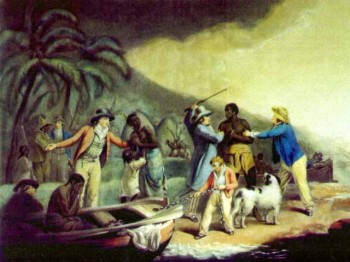| The
capture of Africans, who were then transported to global markets and
sold for profit. |
 |
|
"The
Slave Trade" by George Morland, 1791
|
The Atlantic slave
trade began in the fifteenth century as Portugal explored the African
coast in search of trading venues. In time, the Dutch, French, English,
and other countries were also involved. Africans who sold captured enemies
to traders played a vital role. Aboard ship, captives suffered horrible
conditions and thousands died at sea. Markets for slaves expanded with
colonial settlement
of the Western Hemisphere. Latin America became a market for slaves when
Native Americans did not satisfy the Spanish and Portuguese demands for
labor. In 1619 a Dutch trading ship brought the first African slaves to
Virginia. In England, John Wesley denounced
the slave trade; in America, a movement called "abolitionism"
worked to abolish slavery. The English evangelical, William Wilberforce,
worked tirelessly to end the slave trade
and slavery within the British Empire. By 1808 the slave trade to the
United States was illegal, but the demand for slave labor was met through
"natural increase" so that by 1860 the total U.S. slave population approached
4 million.
|